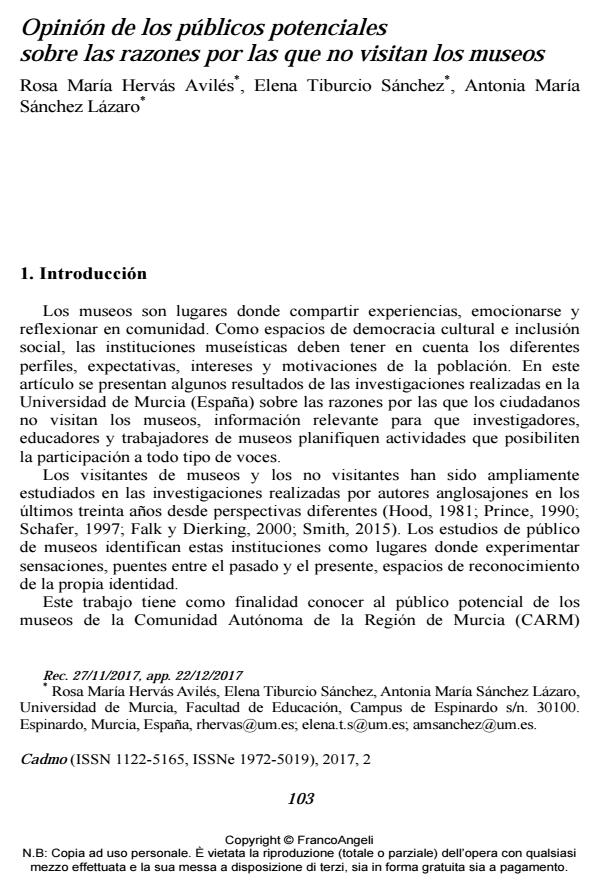Opinión de los públicos potenciales sobre las razones por las que no visitan los museos
Journal title CADMO
Author/s Rosa María Hervás Avilés, Elena Tiburcio Sánchez, Antonia María Sánchez Lázaro
Publishing Year 2018 Issue 2017/2
Language Spanish Pages 13 P. 103-115 File size 159 KB
DOI 10.3280/CAD2017-002011
DOI is like a bar code for intellectual property: to have more infomation
click here
Below, you can see the article first page
If you want to buy this article in PDF format, you can do it, following the instructions to buy download credits

FrancoAngeli is member of Publishers International Linking Association, Inc (PILA), a not-for-profit association which run the CrossRef service enabling links to and from online scholarly content.
- Brida, J.G., Dale, C., Scuderi, R. (2014), “How often to a Museum? Motivations matter”, BEMPS-Bozen Economics & Management Paper Series, 16, pp. 1-20.
- Boyd, J., Evans, L. (2014), Multiculturalism in art museums today. Lanham: Rowman & Littlefield.
- Carbó, G., Mayolas, M. (2005), “Museos: ¿templos de las musas o centro de la ciudadanía?”, Revista Virtual Zona Pública, 1, pp. 1-6.
- Celaya, J. (2012), “Hacia una cultura compartida. Más allá del marketing de museos en las redes sociales”, Telos: Revista de pensamiento sobre tecnología y sociedad, 90, pp. 106-107.
- Colino, F., De la Peña, P. (2005), “El cansancio en los museos”, Arqueoweb: Revista sobre Arqueología en Internet, 7 (1), pp. 1-8.
- Falk, J.H., Dierking, L.D. (2000), Learning from Museums: Visitor Experiences and the Making of Meaning. Lanham: Altamira Press.
- Ham, S.H. (1992), Environmental Interpretation: A Practical Guide for People with Big Ideas and Small Budgets. Golden (Colorado): Fulcrum Publishing.
- Hernández, F. (2011), “Museos, multiculturalidad e inclusión social. El Pensamiento Museológico Contemporáneo”, II Seminario de Investigación en Museología del Consejo Internacional de Museos-ICOM - Buenos Aires, pp. 407-417.
- Hood, M.G. (1981), Adult Attitudes Toward Leisure Choices in Relation to Museum Participation. Ohio: The Ohio State University.
- Hooper-Greenhill, E. (1994), Los museos y sus visitante. Gijón: Ediciones Trea.
- ICOM. (2007), Estatutos del ICOM. Viena: ICOM.
- Kay, P., Wong, E., Polonsky, M. (2008), “Understanding Barriers to Attendance and Non-attendance at Arts and Cultural Institutions: A Conceptual Framework”, in ANZMAC 2008: Australian and New Zealand Marketing Academy Conference 2008. Marketing: Shifting the Focus from Mainstream to Offbeat, edited by Daniela Spanjaard, Sara Denize and Neeru Sharma, 1-7. Promaco Conventions: Canning Bridge, W.A.
- Kotler, N.G., Kotler, P., Kotler, W.I. (2008), Museum Marketing and Strategy: Designing Missions, Building Audiences, Generating Revenue and Resources. New York: John Wiley & Sons.
- Laboratorio Permanente de Público de Museos (2011), Conociendo a nuestros visitantes (Informe general). Madrid: Secretaría General Técnica Subdirección General de Documentación y Publicaciones.
- Laboratorio Permanente de Público de Museos (2012), Conociendo a todos los públicos. ¿Qué imágenes se asocian a los museos?. Madrid: Secretaría General Técnica Subdirección General de Documentación y Publicaciones.
- Levent, N., Pascual-Leone, A. (2014), The Multisensory Museum. Cross-Disciplinary Perspectives on Touch, Sound, Smell, Memory, and Space. Lanham: Rowman & Littlefield.
- Macdonald, S. (ed). (2011), A Companion to Museum Studies, Vol. 39. West Sussex: Wiley-Blackwell.
- Mason, D., McCarthy, C. (2006), “The Feeling of Exclusion: Young Peoples’ Perceptions of Art Galleries”, Museum Management and Curatoship, 21 (1), pp. 20-31.
- McCarthy, K.F., Jinnett, K.J. (2001), A New Framework for Building Participation in the Arts. Santa Mónica: Rand Corporation.
- Mendoza, M.L. (2011), Museo y ocio. Nuevos paradigmas para el museo del siglo XXI, http://ler.letras.up.pt/uploads/ficheiros/10372.pdf.
- Merriman, N. (1991), Beyond the Glass Case: The Past, the Heritage and the Public in Britain. Leicester & New York (NY): Leicester University Press.
- Office of Policy and Analysis (2001), The Smithsonian Institution Council Report: Barriers to Engagement at Smithsonian International Art Museums. Washington: Smithsonian Institution.
- Prentice, R., Guerin, S., McGugan, S. (1998), “Visitor learning at a Heritage Attraction: A Case Study of Discovery as a Media Product”, Tourism Management, 19 (1), pp. 5-23.
- Presta, I. (2010). “Non-visitors: Who are They, why is it important to know Them?”, Cadmo (1), pp. 49-61.
- Prince, D.R. (1983), “Behavioural Consistency and Visitor Attraction”, The International Journal of Museum Management and Curatorship, 2 (3), pp. 235-247.
- Prince, D.R. (1990), “Factors Influencing Museum Visits: An Empirical Evaluation of Audience Selection”, Museum Management and Curatorship, 9 (2), pp.149-168.
- Schafer, H. (1997), “Non-visitor Research: An Important Addition to the Unknown”, Visitor Studies: Theory, Research and Practice, 9, pp. 195-205.
- Shrapnel, E. (2012), Engaging Young Adults in Museums. An Audience Research Study, http://australianmuseum.net.au/Uploads/Documents/26111/Final%20Project.pdf.
- Silberberg, T. 1995), “Cultural Tourism and Business Opportunities for Museums and Heritage Sites”, Tourism Management, 16 (5), pp. 361-365.
- Smith, L. (2006), Uses of Heritage. London: Routledge.
- Smith, L. (2015), “Theorizing Museum and Heritage Visiting”, in A. Witcomb, K. Message (eds), The International Handbooks of Museum Studies. Chichester: Wiley Blackwell, pp. 459-484.
- Smith, L. (2017), “‘We are… we are Everything’: The Politics of Recognition and Misrecognition at Immigration Museums”, Museum & Society, 15 (1), pp. 69-86.
- Smith, L., Fouseki, K. (2011), “The Role of Museums as ‘Places of Social Justice’”, Representing Enslavement and Abolition in Museums: Ambiguous Engagements, 3, pp. 97-115.
- Sousa, A.A. (1996), “El constructivismo estructuralista: La teoría de las clases sociales de Pierre Bourdieu”, Reis, 75, pp. 145-172.
- Wacquant, L. (2005), “El suicidio de Bourdieu”, in I. Jiménez (coord.), Ensayos sobre Pierre Bourdieu y su obra. México: Plaza y Valdés, pp. 231-238.
Rosa María Hervás Avilés, Elena Tiburcio Sánchez, Antonia María Sánchez Lázaro, Opinión de los públicos potenciales sobre las razones por las que no visitan los museos in "CADMO" 2/2017, pp 103-115, DOI: 10.3280/CAD2017-002011